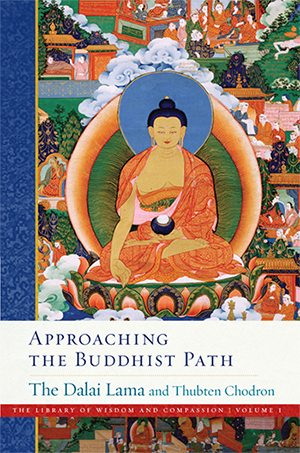Working with Fear
Understanding the Difference between Afflictive Fear and Wisdom-Fear
By The Dalai Lama and Thubten ChodronFear is an emotion that can be spoken of in two ways. In common parlance, fear is usually associated with panic, anxiety, worry, and distress; it is considered a negative emotion because it feels so unpleasant and is often based on unrealistic thinking. From a Buddhist viewpoint, this kind of fear is afflictive because it is based on exaggeration and self-preoccupation, and it leads a person to engage in actions or make decisions that are unwise.
Another kind of fear has an element of wisdom; it is an awareness of possible danger that causes us to exercise caution. While this fear may sometimes feel unpleasant, it is useful and is free from the emotional torment of ordinary fear. For example, awareness that you live in an area that is prone to earthquakes encourages people to make and heed building codes to protect buildings from collapsing. People lay careful plans and take precautions without being immersed in uncontrollable panic. This wisdom-fear is also at work when we merge onto a highway. Aware of the danger of other vehicles driving at high speeds, we drive carefully. Parents instill in young children a respectful fear of matches. In the above examples, fear is useful and is not afflictive. The difference between afflictive fear and wisdom-fear is the presence or absence of exaggeration. When we are attuned to facts of the situation, fear is not distorted, but when we exaggerate some aspect of the situation, fear is unrealistic and leads to suffering.
Certain meditations in the stages of the path are designed to arouse wisdom-fear in us. When we meditate on the disadvantages of cyclic existence, wisdom-fear motivates us to practice the path to liberate ourselves from saṃsāric suffering. The meditation on death is meant to provoke not an emotional, panicky fear of death, which is of no benefit at all, but a wise awareness of our mortality that leads us to set good priorities in life, abandon harmful actions, and live ethically and kindly.
In Thailand, some monks from the forest tradition meditate in fearful places such as cemeteries, jungles, and forests with ferocious animals. Before 1959, meditators in Tibet did the same. If panicky fear arose in their minds, motivated by the suffering that such fear produces, they would make a strong effort to generate samadhi or the wisdom realizing emptiness in order to overcome it. Ajahn Mun, a famous ascetic Thai monk who lived in the late nineteenth and early twentieth century, and his disciples practiced in this way, and there are many stories of them entering deep states of samadhi when encountering a tiger in the jungle. The great Tibetan yogi Milarepa practiced similarly, and meditators in the Chod lineage deliberately invoke spirits and ghosts to spur them to generate wisdom and a deep aspiration to bring about others’ welfare and their own awakening.
Some scriptures speak of using the presence or absence of panicky fear as a way to examine whether or not a person is liberated from samsara or an arhat. When that person is meditating or sitting casually, someone makes a sudden, sharp, loud sound. If the person does not jump or gasp with fear, it is said that he has attained high levels of the path. According to this example, it seems that some level of self-grasping is present when an ordinary person experiences fear but is absent when they are liberated from cyclic existence.
Sometimes it is said that bodhisattvas fear samsara as well as the personal peace of an arhat’s nirvana. While the word “fear” is used to indicate their unwillingness to stay in either of these states, it is not the fear that we ordinary people experience. Our fear is usually based on self-grasping and self-centeredness, while bodhisattvas’ fear is underlain with compassion and wisdom that wants to attain buddhahood in order to benefit others as soon as they can.
Working with Fear, Developing Courage
Above we briefly considered the two types of fear, one based on wisdom and the other that succumbs to panic. The first type of fear stems from reason and is healthy. When we light a fire, we are aware of the danger and take care to avoid it. That fear protects us. Similarly, when we correctly analyze the causes of cyclic existence, we have a wise fear of them and that makes us conscientious about our moods and actions. This wisdom-based fear is important in daily life and on the path.
 Panicked fear is problematic because it prevents us from seeing the situation clearly. For example, when I was a child and passed through some dark rooms in the Potala, I feared someone was hiding there. If just a small mouse ran by, I jumped with fright. This kind of fear is due to our imagination; it is mentally created. Getting accurate information and changing our view of the situation can counteract it. For example, when we feel insecure, fearful, and lonely, we can meditate on the kindness we have received from others so that a sense of connection and gratitude arises in our hearts and we know we have support. If we are skeptical and suspicious of someone, it is helpful to consider him as another human being, just like us. In that way, our attitude will be more receptive, and we will be able to assess the situation with greater clarity and wisdom.
Panicked fear is problematic because it prevents us from seeing the situation clearly. For example, when I was a child and passed through some dark rooms in the Potala, I feared someone was hiding there. If just a small mouse ran by, I jumped with fright. This kind of fear is due to our imagination; it is mentally created. Getting accurate information and changing our view of the situation can counteract it. For example, when we feel insecure, fearful, and lonely, we can meditate on the kindness we have received from others so that a sense of connection and gratitude arises in our hearts and we know we have support. If we are skeptical and suspicious of someone, it is helpful to consider him as another human being, just like us. In that way, our attitude will be more receptive, and we will be able to assess the situation with greater clarity and wisdom.
Another unrealistic fear may occur when we are threatened with losing our job. Our minds imagine that we will immediately be homeless, sitting on the street with our hungry children. Applying our intelligence, we should investigate whether we are viewing the situation accurately or exaggerating certain aspects. We may find that the situation is unlikely to occur as we imagined it, and even if it did, we have skills to manage it. There are resources in society and in our network of friends and relatives to help us, so we need not paint a dire picture of circumstances that don’t exist at this moment.
Some people look at the political, economic, social, and environmental situation of the world and develop a wisdom-fear that inspires them to work to prevent harm to the planet and its living beings. Looking at the same situation, other people develop a despondent fear. Such a discouraged mental state immobilizes them, and their wish to help gets lost amid waves of despair. To counter this, we must constantly maintain our compassion and keep our hearts open, so that no matter what others’ responses are, we remain earnest.
Courage comes from the way we regard situations. For example, from one viewpoint the current situation in Tibet is dire; from another there is hope. Focusing on the positive, while being aware of but not discouraged by the negative, enables us to make every effort to improve conditions.
One single practice or method alone cannot develop courage; working with fear requires contemplation of several topics over a period of time. These topics include the preciousness of our human life; the potential of ourselves and all others to become fully awakened buddhas; the compassionate, awakening activities of the buddhas and bodhisattvas; the life stories of great masters; the kindness we have received from all sentient beings; and love, compassion, and taking others’ suffering and giving them our happiness. These will uplift and balance the mind so that we then view situations from a broad perspective.
In addition to courage, we need confidence. To develop this, I keep in mind some basic beliefs: Human nature is gentle and compassionate. Each and every one of us does not want suffering, and we have a right to try to overcome it. All beings have the potential to become wise, altruistic buddhas. Reflecting on these gives me inner strength and determination. A compassionate motivation and a clear, beneficial goal give me self-confidence and destroy doubts. In other words, confidence arises not from being successful in our projects but from engaging in them with a wise and kind motivation.
Human beings have remarkable intelligence, which if applied correctly, can solve problems and conflicts. Fatalistic attitudes are useless. We have the capacity to prevent hardships and improve what is good; we must do our best to use our abilities in constructive ways. If we make every effort while working with fear, and still fail, we need not have regrets. We can accept what happens. However, if due to lack of care or hope, negative things happen, that is extremely sad.
The Dalai Lama is the spiritual leader of the Tibetan people and a Nobel Peace Prize recipient. Thubten Chodron has been a Buddhist nun since 1977. She is the founder and abbess of Sravasti Abbey, a Buddhist monastery in Washington state. This is article is an adapted from their book Approaching The Buddhist Path, excerpted here with permission from Wisdom Publications.
Image courtesy of andrea floris on Flickr
